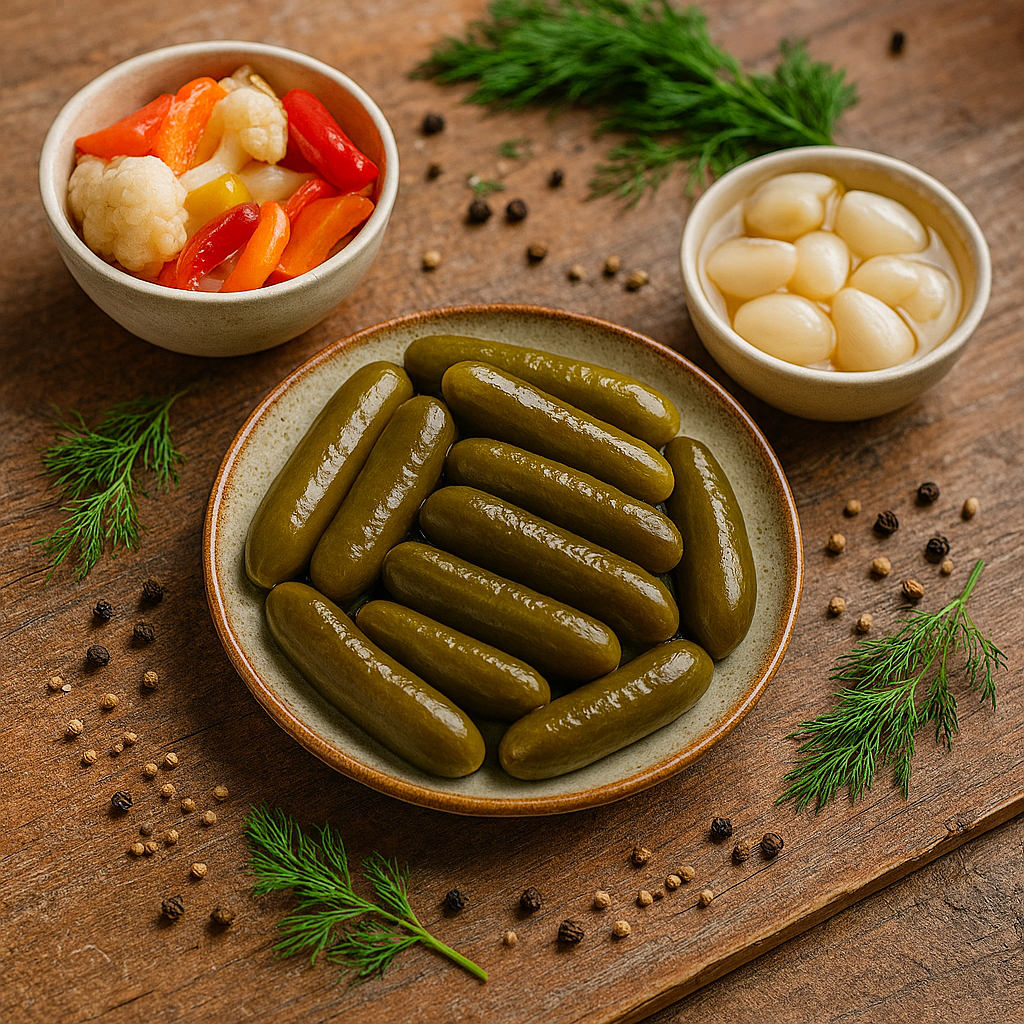Persian Pickles, Torshi, and Salted Vegetables

A Complete Guide to Iranian Pickles, Salted Vegetables, and Other Fermented Products
Introduction
Pickles and salted vegetables are among the oldest food preservation methods in the world. These traditional products not only extend the shelf life of fruits and vegetables but also add a delightful and distinctive flavor to meals.
In Iran, pickle and brine production is a major part of both traditional and industrial food industries, offering an impressive variety that reflects the country’s rich culinary heritage.
Section 1: Salted Products (Shourha)
Definition
A salted product (Shour) is made by immersing vegetables or fruits in a saltwater (brine) solution. The process typically involves natural lactic fermentation or the use of a salty environment to prevent microbial spoilage.
Popular Types of Salted Vegetables in Iran
- Salted Cucumber (Khiar Shour):
The most famous type of pickle in Iran and around the world. Cucumbers are soaked in brine, sometimes with vinegar and spices, to achieve a crisp and tangy flavor. - Salted Olives:
Raw olives contain natural bitterness, which is removed through the salting process to make them edible and flavorful. - Salted Vine Leaves (Barge Mo Shour):
Commonly used for making dolma (stuffed grape leaves). The leaves are preserved in brine to maintain freshness and flexibility. - Salted Garlic and Salted Peppers:
These have not only a rich flavor but also strong antioxidant and antibacterial properties.
* Note: The varieties listed above represent only a small portion of the many salted vegetables produced in Iran. There are dozens of other types—such as salted cauliflower, salted okra, and salted cabbage—each with its own distinct taste and regional origin.
Section 2: Pickles (Torshiha)
Definition
A pickle (Torshi) is a food product preserved in vinegar (acetic acid) with added salt, herbs, and spices. The acidic environment prevents the growth of harmful microorganisms and gives the product its unique sour flavor.
Popular Iranian Pickle Varieties
- Garlic Pickle (Torshi Sir):
One of the most popular types of pickles in Iran. After several months in vinegar, garlic turns brown and develops a smooth, mellow taste. - Chili Pepper Pickle (Torshi Felfel):
Known for its hot and spicy flavor, it pairs perfectly with meat dishes. - Liteh Pickle (Torshi Liteh):
A combination of chopped eggplant, carrots, cauliflower, garlic, and peppers mixed with aromatic herbs and vinegar. - Mixed Pickle (Torshi Mokhalat):
A colorful blend of chopped vegetables such as cauliflower, cucumber, carrots, eggplant, and bell peppers.
Note: Iran is one of the richest countries in terms of pickle diversity. There are many more local varieties such as stuffed eggplant pickle, mango pickle, mushroom pickle, and purple cabbage pickle, which differ by region and traditional recipe.
Section 3: Other Fermented and Pickled Products
- Zeytoon Parvardeh (Seasoned Olive Paste):
A delicious combination of chopped olives, pomegranate paste, walnuts, garlic, aromatic herbs, and traditional spices. It’s especially popular in northern Iran (Gilan province) and is known for its bold, tangy taste and high nutritional value. - Stuffed Olives (Dolmeh Zeytoon):
Pitted olives filled with ingredients such as bell pepper, almonds, or carrots. Widely used in restaurants, fast food, and international catering industries. - Pickled Olives with Mixed Vegetables:
A creative variation combining olives with vinegar, herbs, or vegetables for a unique Mediterranean-style flavor.
Section 4: Production and Preservation Process
General Steps for Producing Salted Vegetables
- Washing raw materials thoroughly
- Preparing a saltwater brine (usually 10–15% salt concentration)
- Adding flavoring agents such as garlic, dill, or chili peppers
- Allowing natural fermentation for several days or weeks under controlled temperature
- Packing in glass jars or plastic containers
General Steps for Producing Pickles
- Cutting and preparing the raw materials
- Mixing with salt, herbs, and spices
- Adding natural or industrial vinegar
- Letting the product mature for 10 days to several months
- Hygienic packaging for storage or export
Section 5: Market and Export Opportunities
Thanks to its rich agricultural resources, Iran is one of the leading producers of pickles and salted vegetables in the Middle East.
Iranian products such as salted cucumbers, Liteh pickles, Zeytoon Parvardeh, and garlic pickles are especially popular in neighboring and European markets.
Upgrading packaging quality, ensuring consistent flavor profiles, and using natural vinegar can significantly increase the export value of this industry.
Section 6: B2B Trade and Export Capability
Tak Ava Trading Company specializes in sourcing, customizing, and exporting a wide range of Iranian pickles, salted vegetables, and fermented products.
With deep expertise in food export and supply-chain management, Tak Ava can handle exclusive export projects or utilize factory surplus capacity to produce goods according to each client’s specifications and standards.
All partnerships are managed on a B2B basis, allowing maximum flexibility in formulation, packaging, private labeling, and international logistics — ideal for brands, retailers, and food distributors seeking authentic Iranian pickles under their own label.
Conclusion
Pickles and salted vegetables are an integral part of Iranian culinary culture. These flavorful and colorful products not only enhance meals but also hold great nutritional and commercial value.
The wide variety of Iranian pickles and the flexible production capabilities of companies like Tak Ava Trading Co. create a strong opportunity to expand exports and introduce the authentic taste of Persian pickles and salted foods to global markets.


